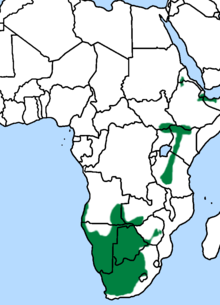Steppe falcon
| Steppe falcon | ||||||||||||
|---|---|---|---|---|---|---|---|---|---|---|---|---|

Steppe falcon ( Falco rupicoloides rupicoloides ) |
||||||||||||
| Systematics | ||||||||||||
|
||||||||||||
| Scientific name | ||||||||||||
| Falco rupicoloides | ||||||||||||
| A. Smith , 1829 |
The greater kestrel ( Falco rupicoloides ) is a beheimateter in Africa, the kestrel -like bird from the family of Falk-like (Falconidae). There are three subspecies .
Surname
The German name "Steppenfalke" is a reference to the habitat of this species . The steppe falcon owes its scientific name ( Falco rupicoloides ), as well as a variant of the name in English ( White-eyed Kestrel , next to the more common Greater Kestrel ) to its whitish iris - in contrast to all other falcons .
distribution
The steppe falcon inhabits open plains or semi-deserts with acacia trees in southern Africa at heights of up to 2100 m. A distinction is made between three subspecies that inhabit clearly separated areas:
- Falco rupicoloides rupicoloides is the nominate form ; it is widespread in southern Africa from the northern Transvaal to Namibia , Angola and Zambia . The photo above right was taken in the Etosha National Park in Namibia.
- F. r. arthuri - Distribution: Tanzania and Kenya
- F. r. fieldi - Distribution: Somalia and Ethiopia
Appearance
With a body length of 36-40 cm, the steppe falcon has a wing length of 25.9 to 29.0 cm (males) or 26.5 to 29.4 cm (females). Its weight is around 250 (males) and 300 grams (females). The head and neck show black vertical stripes on a pale rust-colored background; The back and shoulders are also rust brown and patterned with bold black crossbars. The tail is slate-colored to black and transversely banded, the lower abdominal plumage beige. The iris of the eyes is white, the beak is blue-gray. The wax skin and legs are yellow.
Way of hunting and food
The steppe falcon mainly prey on insects, more rarely small mammals, birds and reptiles (including snakes) on the ground. In order to spot them, he spends a large part of his time sitting alone or in pairs in treetops or on telegraph poles ("hide hunting"). Much less often than the kestrel , it shakes over the vast plains of its hunting habitat in order to quickly dive down when it sees a prey.
Reproduction
They breed in the abandoned nests of other birds, usually in the nest of a Cape raven or a crow , and rarely in tree hollows. A clutch usually consists of three to four eggs, the incubation period is 32–33 days, the nestling period (the time from hatching to the fledgling of the young ) 30–34 days. During the breeding season, the male hunts alone.
literature
- James Ferguson-Lees , David A. Christie: Raptors of the World. Christopher Helm Publishers Ltd, London 2001, ISBN 0-7136-8026-1 .
Web links
- photos
- Videos, photos and sound recordings on Falco rupicoloides in the Internet Bird Collection
- Falco rupicoloides inthe IUCN 2013 Red List of Threatened Species . Listed by: BirdLife International, 2012. Retrieved September 21, 2013.
